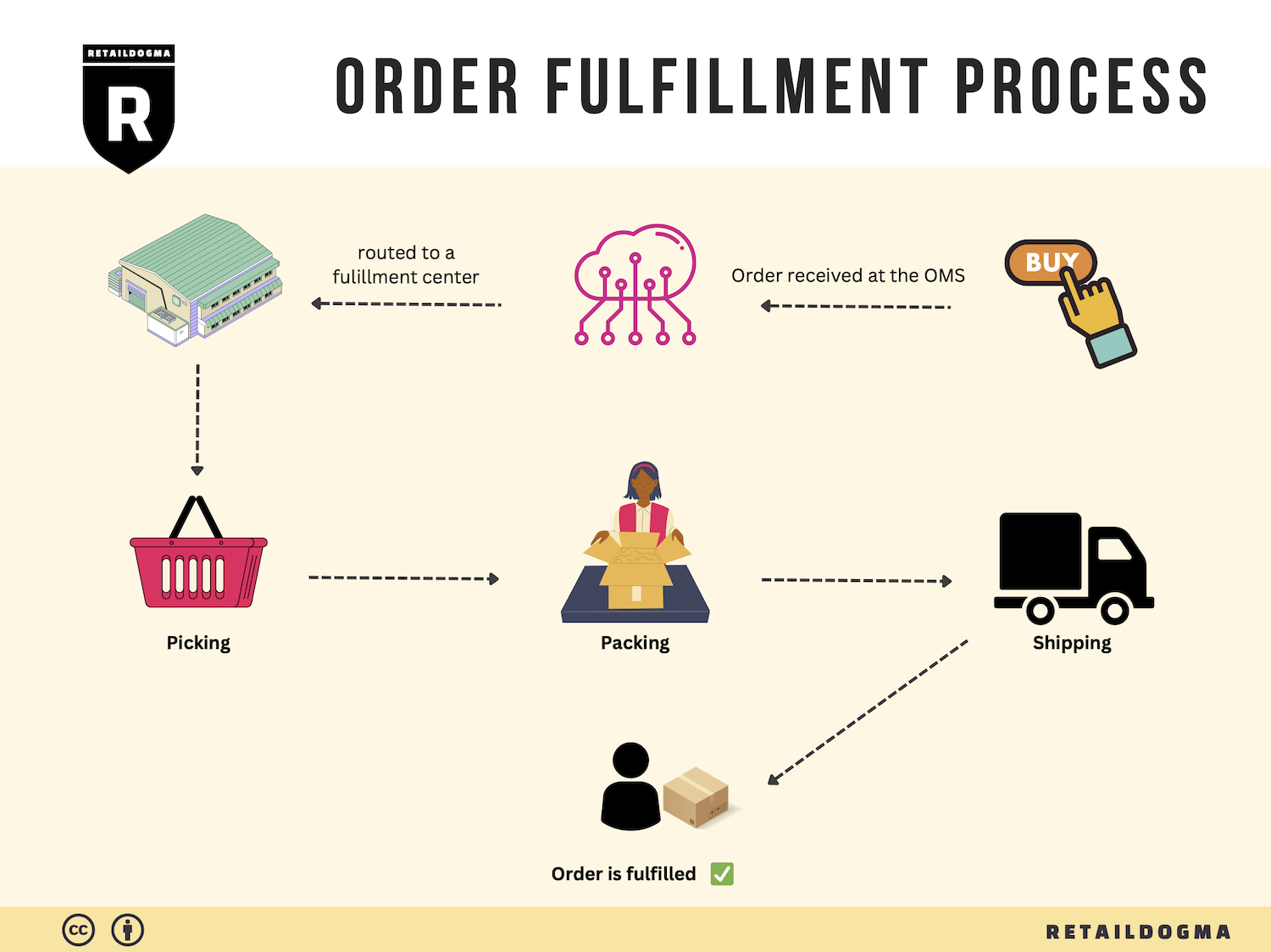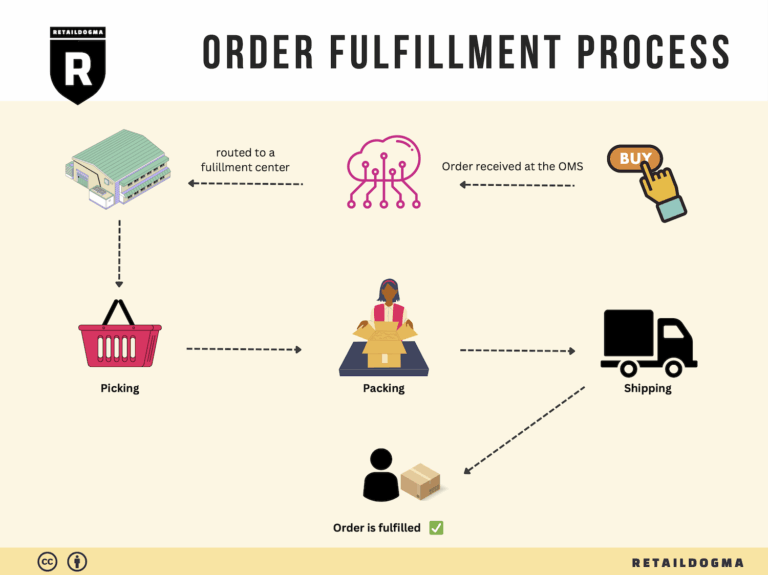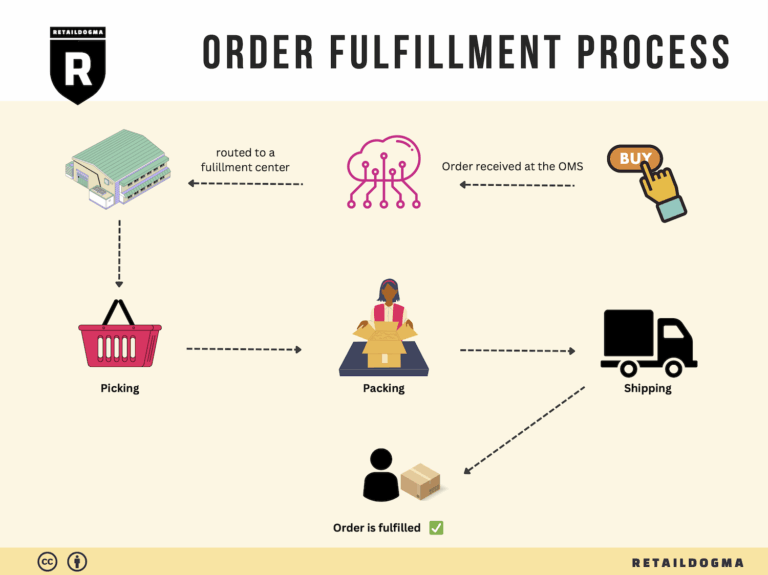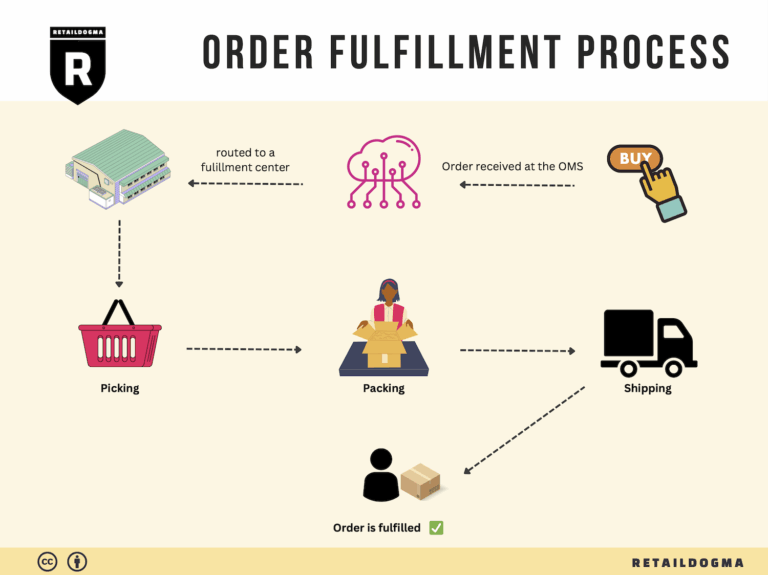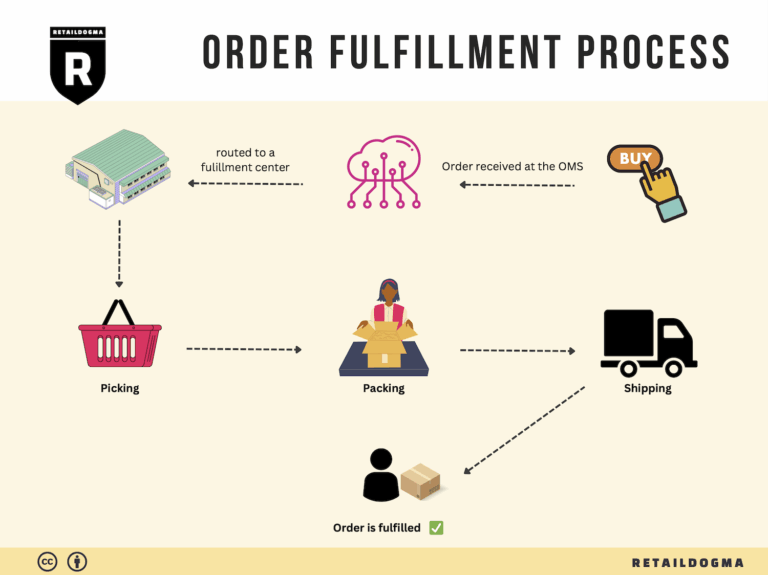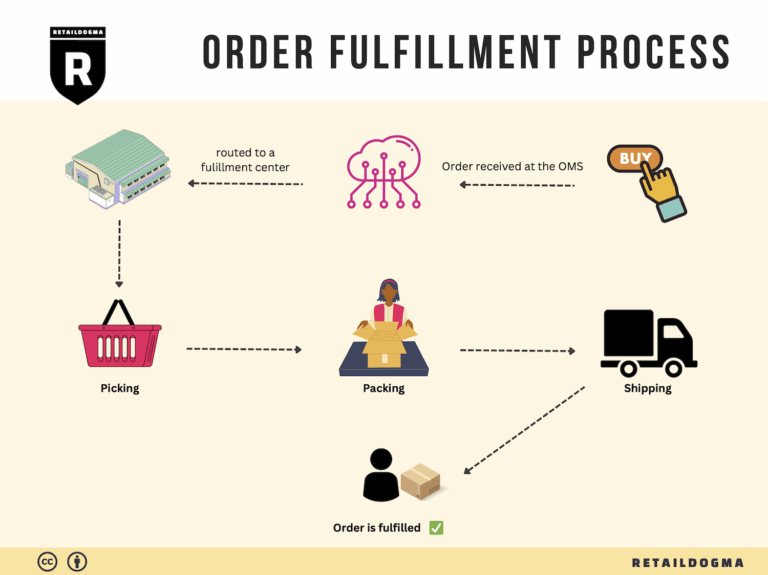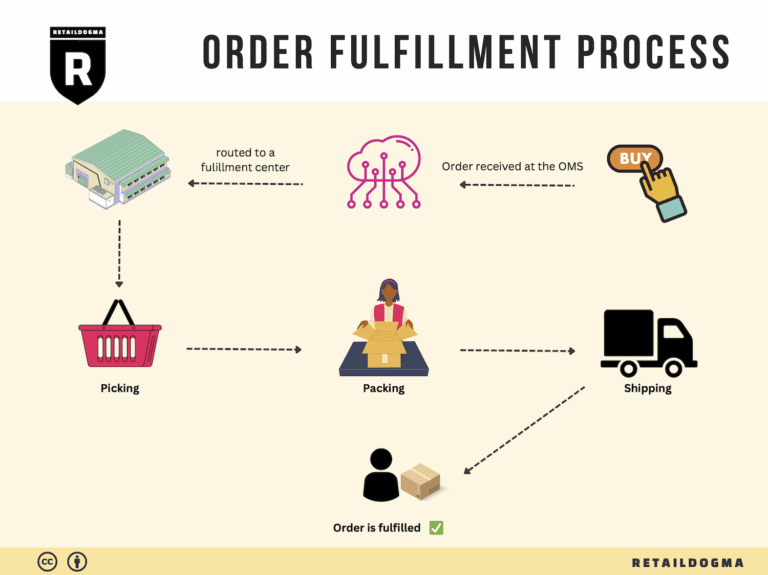What Is A Fulfillment Center? A Complete Guide (2025)
What is E-commerce Fulfillment? An Introduction for Growing Businesses
Understanding E-commerce Fulfillment
As an e-commerce business owner, you’ve likely experienced the mounting pressure of packing and shipping orders as your sales grow. The excitement of increased demand can quickly turn into stress when faced with the logistics of fulfilling each order efficiently and accurately. Fulfillment is not just a back-end process; it’s a crucial aspect of your customer experience that can significantly impact your brand reputation and bottom line.
At its core, fulfillment is the process of getting a product from your inventory to your customer’s doorstep. This includes everything from receiving an order, picking the right items from your stock, packing them securely, and shipping them out, to managing returns and exchanges. As your business scales, the complexity of this process can become overwhelming, making it essential to understand the various fulfillment models available to you.
This guide will delve into the different e-commerce fulfillment models, including Third-Party Logistics (3PL) and Fulfillment by Amazon (FBA), helping you navigate the options suited to your business needs. We will explore the core services offered by fulfillment partners, such as inventory management, order processing, and shipping logistics. Understanding these services will empower you to make informed decisions that enhance your operational efficiency.
Choosing the right fulfillment partner is a critical step in your growth strategy. We’ll discuss key factors to consider when evaluating potential partners, including their technology, scalability, reliability, and customer service capabilities. Additionally, we will provide insights into pricing structures to ensure you can budget effectively while maintaining quality service.
Ultimately, this guide aims to empower you with the knowledge and tools necessary to make smart, strategic decisions about your logistics. By optimizing your fulfillment process, you can focus on what you do best—growing your business and delighting your customers. Whether you’re just starting or looking to scale, understanding e-commerce fulfillment is vital to your success in the competitive online marketplace.
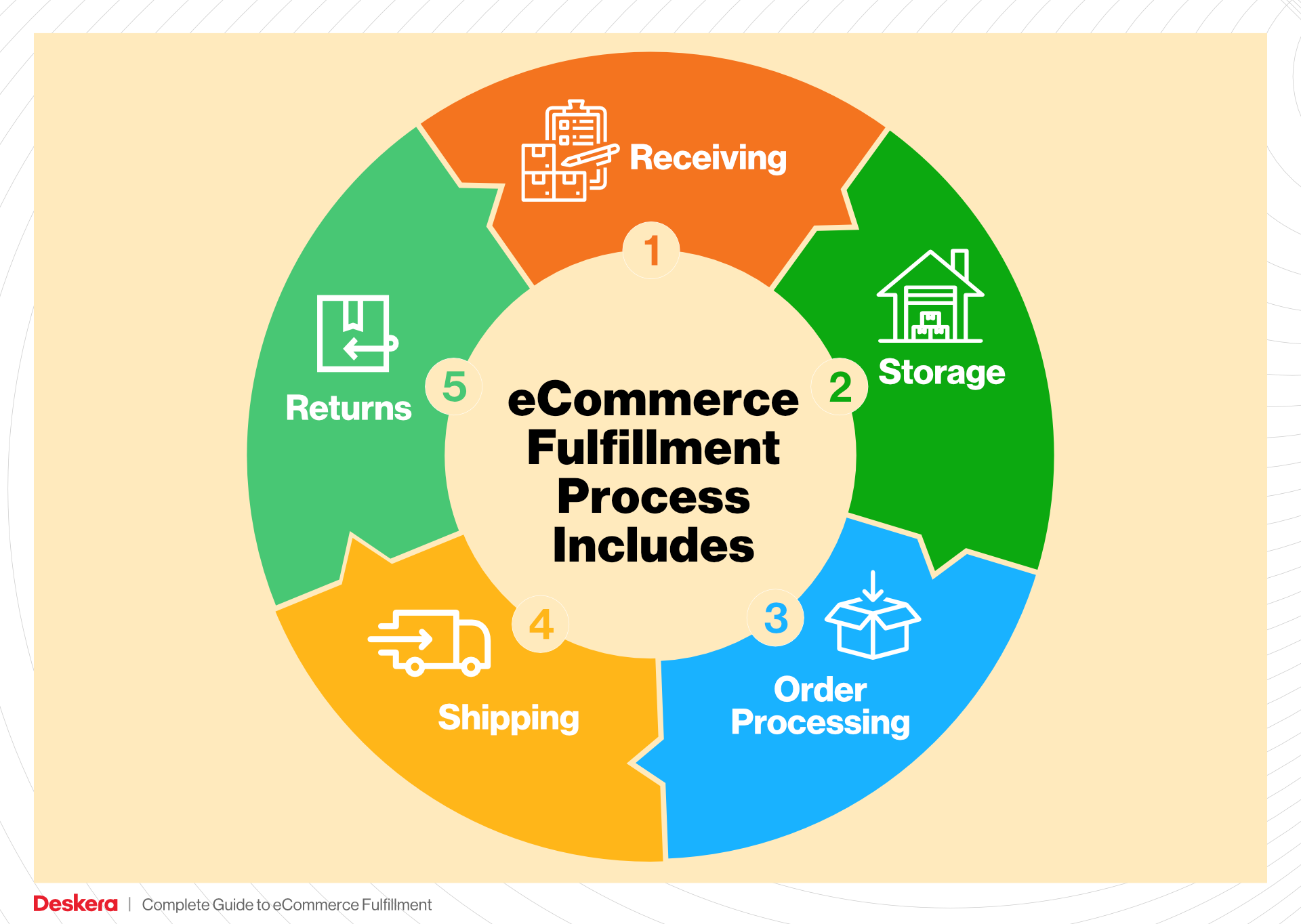
What You’ll Learn In This Guide
- What is E-commerce Fulfillment? An Introduction for Growing Businesses
- The Order Fulfillment Process: From ‘Buy’ Button to Customer’s Door
- Comparing Fulfillment Models: In-House vs. 3PL vs. Dropshipping
- A Deep Dive into Amazon FBA: Pros, Cons, and Who It’s For
- Core Services Offered by Fulfillment Centers
- How to Choose a Fulfillment Partner: A 6-Point Checklist
- Understanding Fulfillment Pricing: A Breakdown of Common Fees
- Frequently Asked Questions (FAQs) about Fulfillment
- Conclusion: Is Outsourcing Fulfillment the Right Move for Your Business?
- Important Disclaimer
The Order Fulfillment Process: From ‘Buy’ Button to Customer’s Door
1. Receiving Inventory
The order fulfillment process begins with receiving inventory into your warehouse or fulfillment center. When products arrive, they must be checked against purchase orders to ensure that the correct quantities and items have been delivered. This step is crucial because discrepancies can lead to stock shortages or overstock situations that disrupt the entire supply chain.
During this phase, a key term to understand is SKU (Stock Keeping Unit), which serves as a unique identifier for each product. Properly managing SKUs allows businesses to maintain accurate records and streamline the receiving process. Implementing a barcode scanning system can significantly enhance efficiency, as it reduces human error and speeds up inventory checks.
2. Warehouse Storage
Once inventory is received and verified, it moves to the warehouse storage phase. Efficient storage is vital for maximizing space and ensuring that products can be easily accessed when orders are placed. This often involves categorizing items based on their type, size, or demand, and placing them in designated locations within the warehouse.
A critical aspect of this step is the concept of ABC analysis, which categorizes inventory into three classes: A (high value, low quantity), B (moderate value and quantity), and C (low value, high quantity). By prioritizing space for high-demand items (A), businesses can significantly reduce picking times and improve overall efficiency. An effective warehouse management system (WMS) can automate this process, providing real-time inventory tracking and location data.
3. Order Picking
As customers place orders, the next step is order picking. This involves selecting items from their storage locations to fulfill customer requests. Efficient picking strategies are essential for minimizing errors and maximizing speed. Common methods include batch picking, where multiple orders are picked simultaneously, and zone picking, where pickers are assigned specific areas of the warehouse.
A vital tool in this process is the pick list, which outlines the items and quantities needed for each order. By using technology such as handheld scanners or mobile devices, employees can quickly verify that they are picking the correct items, further enhancing accuracy and reducing the risk of shipping errors. This step is crucial not only for fulfilling orders accurately but also for maintaining customer satisfaction.
4. Order Packing
After items are picked, they move to the order packing stage. This step involves carefully packaging items to ensure they arrive at the customer’s door in perfect condition. Proper packing minimizes damage during transit, which is essential for maintaining brand reputation and customer loyalty.

Here, businesses should consider using packaging materials that are appropriate for the items being shipped, as well as incorporating branding elements to enhance the unboxing experience. Packing slips, which detail the contents of the package, should also be included to provide customers with essential information. An effective packing process can reduce returns and enhance customer satisfaction, making it a critical part of the fulfillment journey.
5. Shipping & Delivery
The final step in the order fulfillment process is shipping and delivery. Once packages are packed, they are labeled and dispatched to the shipping carrier. The choice of carrier can significantly impact delivery speed and costs, so businesses must evaluate options based on their specific needs and customer expectations.
During this phase, it’s important to provide customers with tracking information. This transparency allows customers to monitor their order’s progress and enhances their overall experience. Efficient shipping strategies can include offering various delivery options, such as standard, expedited, or same-day delivery, depending on customer preferences. By optimizing shipping and delivery, businesses can improve their service level and increase customer retention.
In conclusion, the order fulfillment process is a multi-step operation that requires careful planning and execution. By mastering each step—from receiving inventory to shipping and delivery—businesses can create a seamless experience that keeps customers satisfied and drives growth.
Comparing Fulfillment Models: In-House vs. 3PL vs. Dropshipping
Fulfillment Model Comparison Table
| Model | Who Handles Inventory | Best For (Business Stage) | Key Advantage | Key Disadvantage |
|---|---|---|---|---|
| In-House Fulfillment | The Business | Established, larger firms | Full control over inventory and processes | High overhead costs and resource demands |
| Third-Party Logistics (3PL) | 3PL Provider | Growing, scaling businesses | Scalability and reduced operational burden | Less control over inventory and processes |
| Dropshipping | Supplier | Startups, niche markets | Low upfront investment and risk | Lower profit margins and longer shipping times |
In-House Fulfillment
In-house fulfillment involves managing all aspects of the logistics process internally, including inventory management, order processing, packing, and shipping. This model is typically best suited for established or larger firms that have sufficient capital and resources to maintain their own warehouse facilities. One of the key advantages of in-house fulfillment is the level of control it offers. Businesses can oversee every aspect of their fulfillment process, ensuring that quality standards are met and that they can react quickly to changes in demand or operational challenges. However, this model comes with significant disadvantages. The initial investment in warehouse space, staff, and inventory can be substantial, leading to high overhead costs. Additionally, as the business scales, the operational complexity can increase, requiring more sophisticated inventory management systems and logistics expertise.
Third-Party Logistics (3PL)
Third-party logistics (3PL) refers to outsourcing logistics and fulfillment operations to a specialized provider. This model is particularly advantageous for growing businesses that are looking to scale without the burden of managing a complex logistics operation. A key advantage of 3PL is the ability to tap into the provider’s expertise, technology, and networks, which can lead to faster and more efficient order fulfillment. Additionally, as demand fluctuates, businesses can scale their logistics operations up or down without the need for significant capital investment in infrastructure. However, the reliance on an external provider means that businesses have less control over inventory and fulfillment processes. This can lead to challenges in communication, quality assurance, and inventory accuracy, especially if the 3PL provider does not meet the business’s standards or expectations.
Dropshipping
Dropshipping is a fulfillment model where the retailer does not keep products in stock. Instead, when a product is sold, the retailer purchases the item from a third-party supplier who then ships it directly to the customer. This model is particularly appealing for startups or businesses operating in niche markets, as it requires low upfront investment and minimal risk. Retailers can offer a wide range of products without the need for significant inventory investment, allowing them to test various product lines and market demands without financial exposure. However, dropshipping comes with its own set of challenges. Profit margins can be lower compared to traditional retail models since retailers often pay wholesale prices to suppliers. Additionally, shipping times can be longer and less predictable, leading to potential customer dissatisfaction. As the retailer is not in control of the inventory, managing quality and ensuring timely delivery can be complex and problematic.
Conclusion
Choosing the right fulfillment model depends on the specific needs and stage of your business. In-house fulfillment provides control but requires significant investment, making it ideal for established firms. Third-party logistics offers scalability and operational efficiency, making it suitable for growing businesses. Dropshipping presents a low-risk entry point for startups, though it can lead to lower margins and longer delivery times. Understanding these nuances will allow e-commerce business owners to select the fulfillment strategy that best aligns with their operational goals and customer expectations.
A Deep Dive into Amazon FBA: Pros, Cons, and Who It’s For
Understanding Fulfillment by Amazon (FBA)
Fulfillment by Amazon (FBA) is a service offered by Amazon that allows sellers to store their products in Amazon’s fulfillment centers. Amazon then takes care of storage, packaging, shipping, and customer service on behalf of the sellers. This service enables sellers to leverage Amazon’s extensive logistics network, customer base, and trusted reputation, allowing them to focus more on their business growth rather than the complexities of order fulfillment.
How FBA Works
-
Product Listing: Sellers create product listings on Amazon’s marketplace. They can choose to enroll their products in FBA during this process.
-
Shipping Inventory: Once enrolled, sellers ship their inventory to Amazon’s fulfillment centers. Amazon provides guidelines on how to prepare and package products to ensure they meet the standards required for storage and distribution.
-
Storage: The products are stored in Amazon’s warehouses until a customer places an order. Amazon uses advanced inventory management systems to track stock levels and manage restocking.
-
Order Fulfillment: When a customer orders a product, Amazon handles the entire fulfillment process. This includes picking the product from the warehouse, packing it, and shipping it directly to the customer.
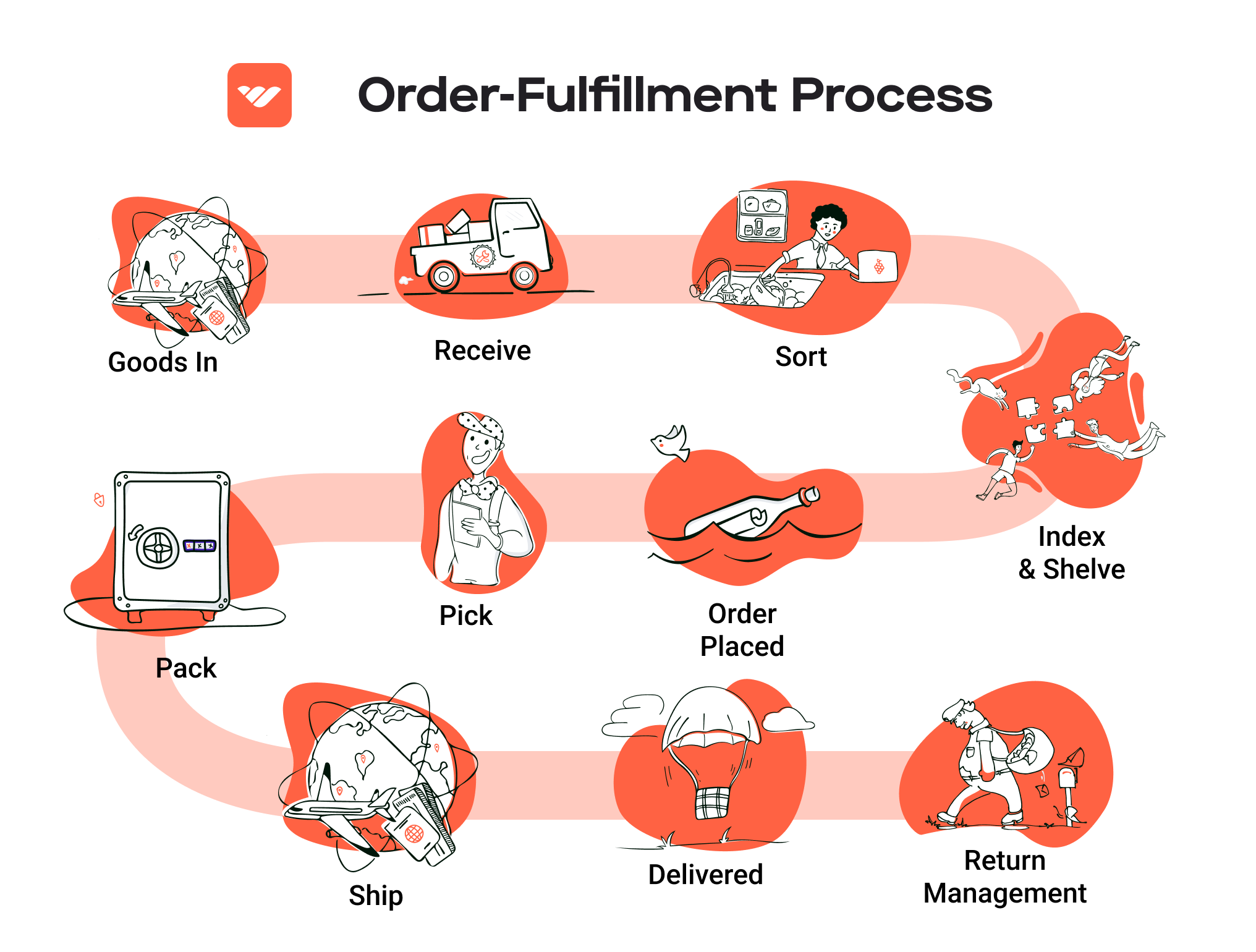
-
Customer Service and Returns: Amazon also manages customer service inquiries and returns for FBA products, allowing sellers to maintain a high level of customer satisfaction without directly handling these tasks.
Pros of Using FBA
-
Prime Eligibility: One of the most significant advantages of FBA is that products become eligible for Amazon Prime. This means they can be offered with free two-day shipping, attracting millions of Prime members who prefer faster delivery options.
-
Increased Customer Trust: Products fulfilled by Amazon typically benefit from increased trust from customers. Amazon’s reputation for reliability and customer service can enhance the perceived value of your products, leading to higher conversion rates.
-
Multi-Channel Fulfillment: FBA is not limited to Amazon’s marketplace. Sellers can utilize FBA to fulfill orders from their own e-commerce websites or other sales channels. This multi-channel fulfillment capability allows businesses to streamline their logistics while offering a consistent customer experience.
-
Scalability: FBA allows businesses to scale quickly. As demand for products increases, sellers can send more inventory to Amazon without needing to invest in warehousing or logistics infrastructure.
-
Time-Saving: By outsourcing fulfillment, sellers can focus on other critical aspects of their business, such as product development, marketing, and customer engagement, rather than managing order fulfillment logistics.
Cons of Using FBA
-
High Fees: FBA comes with a variety of fees, including storage fees, fulfillment fees, and additional charges for long-term storage. These costs can add up quickly and significantly impact the profit margins, especially for low-cost items.
-
Strict Inventory Rules: Amazon has specific requirements and guidelines for inventory management. Sellers must adhere to these rules to avoid penalties, which can include removal of inventory or account suspension.
-
Commingling Risks: When using FBA, sellers’ products may be commingled with similar items from other sellers. This can lead to issues with product quality control, as it may be difficult to trace products back to their original seller if there are complaints or returns.
-
Loss of Control: By outsourcing fulfillment to Amazon, sellers relinquish some control over their logistics. This includes aspects such as packaging, shipping times, and customer interactions, which may not align perfectly with the seller’s brand image.
-
Potential for Account Suspension: Amazon has stringent policies and can suspend seller accounts for various reasons, including poor performance metrics or violations of their guidelines. This can lead to significant disruptions in business operations.
Who is FBA Best For?
FBA is an excellent option for a variety of sellers, particularly those who:
-
Are New to E-commerce: New sellers can benefit from Amazon’s established infrastructure and customer base, making it easier to launch and grow their business without the complexities of fulfillment logistics.
-
Sell High-Volume Products: Sellers with high sales volume can take full advantage of FBA’s efficiencies and scalability, allowing them to manage larger inventories and fulfill more orders seamlessly.
-
Focus on Growth: Businesses looking to expand quickly can leverage FBA to handle logistics, enabling them to focus on marketing, product development, and customer engagement.
-
Offer Products That Fit Amazon’s Model: Products that have high turnover rates, such as consumer goods or seasonal items, are well-suited for FBA, as they can take advantage of Amazon’s fast shipping capabilities.
-
Sell on Multiple Channels: Sellers who want to streamline their fulfillment across various platforms can use FBA to manage orders from both Amazon and their e-commerce sites effectively.
In conclusion, while Fulfillment by Amazon offers significant advantages, including access to a vast customer base and streamlined logistics, it is essential for sellers to weigh these benefits against the potential downsides. Understanding the intricacies of FBA can help e-commerce businesses make informed decisions about whether this fulfillment model aligns with their operational goals and growth strategies.
Core Services Offered by Fulfillment Centers
Inventory Management & Warehousing
Effective inventory management and warehousing are foundational services offered by fulfillment centers that directly impact an e-commerce business’s efficiency and profitability. This service involves the systematic tracking, storing, and managing of products in a centralized warehouse or multiple locations. Fulfillment centers utilize advanced inventory management systems to monitor stock levels in real-time, ensuring that data is accurate and up-to-date.
Benefits:
1. Optimized Stock Levels: By maintaining optimal inventory levels, businesses can avoid stockouts or overstock situations, which can lead to lost sales or increased holding costs.
2. Centralized Control: A centralized inventory system allows e-commerce businesses to manage stock across various sales channels effortlessly, ensuring a consistent customer experience.
3. Data-Driven Insights: Advanced inventory management systems provide valuable analytics on product performance, enabling businesses to make informed decisions about restocking and product offerings.
4. Scalability: As businesses grow, fulfillment centers can easily scale warehousing operations to accommodate increased inventory needs without the hassle of managing physical space themselves.
Pick and Pack Services
Pick and pack services are essential for fulfilling customer orders accurately and efficiently. This process involves selecting the right products from the warehouse (picking) and preparing them for shipment (packing). Fulfillment centers employ specialized staff and technology to ensure that orders are processed quickly and with minimal errors.
Benefits:
1. Speed and Efficiency: With trained personnel and streamlined processes, fulfillment centers can significantly reduce order processing times, leading to faster shipping and happier customers.
2. Accuracy: The use of barcode scanning and automated systems minimizes human error, ensuring that customers receive the correct products, which enhances customer satisfaction and reduces return rates.
3. Custom Packaging Options: Many fulfillment centers offer custom packing solutions that can enhance branding and improve the unboxing experience, adding value to the customer journey.
4. Flexibility: Fulfillment centers can handle varying order sizes, from single-item orders to bulk shipments, accommodating the diverse needs of e-commerce businesses.
Kitting and Assembly
Kitting and assembly services involve the grouping of individual items into ready-to-ship sets or kits, often tailored for specific customer orders or promotional packages. This service is particularly beneficial for businesses that sell complementary products or seasonal items.
Benefits:
1. Enhanced Product Offerings: Kitting allows businesses to create bundled products that can increase average order value by encouraging customers to purchase more items together.
2. Time Savings: By outsourcing the assembly of kits to fulfillment centers, e-commerce businesses can save significant time and labor costs, allowing them to focus on core activities such as marketing and product development.
3. Customization Opportunities: Businesses can create personalized kits based on customer preferences or trends, enhancing customer engagement and satisfaction.
4. Streamlined Inventory Management: Kitting helps in managing inventory more effectively by consolidating multiple products into one SKU, simplifying stock tracking and replenishment processes.
Returns Management (Reverse Logistics)
Returns management, often referred to as reverse logistics, is a critical service provided by fulfillment centers that handles the return of products from customers back to the inventory. This process includes assessing the condition of returned items, restocking them if possible, and managing any necessary repairs or refurbishments.
Benefits:
1. Improved Customer Experience: A seamless returns process can enhance customer trust and loyalty, as customers appreciate hassle-free returns. This can lead to repeat purchases and positive word-of-mouth referrals.
2. Cost Efficiency: Fulfillment centers can streamline the returns process, reducing the time and cost associated with handling returns. They can also help identify patterns in returns, providing insights for product improvement.
3. Inventory Accuracy: By efficiently managing returns, fulfillment centers ensure that inventory levels are updated promptly, which is crucial for maintaining accurate stock levels and preventing future stockouts.
4. Environmental Considerations: Many fulfillment centers are adopting sustainable practices in reverse logistics, helping businesses minimize waste and improve their overall environmental footprint.
In summary, the core services offered by fulfillment centers—inventory management and warehousing, pick and pack services, kitting and assembly, and returns management—are integral to the success of e-commerce businesses. By leveraging these services, businesses can enhance operational efficiency, improve customer satisfaction, and ultimately scale their operations effectively in an increasingly competitive market.
How to Choose a Fulfillment Partner: A 6-Point Checklist
Location & Warehouse Network
Importance:
The location of your fulfillment partner’s warehouses plays a crucial role in shipping efficiency and costs. Ideally, your partner should have a network of warehouses strategically positioned to minimize shipping times and costs to your customers.
Questions to Ask:
– Where are your warehouses located, and how do they align with my target markets?
– What is your average shipping time to key regions?
– How do you manage inventory across multiple locations to ensure efficiency?
Technology & Integrations
Importance:
In today’s omnichannel environment, robust technology is essential for seamless operations. Your fulfillment partner should offer advanced systems that integrate with your e-commerce platforms, inventory management systems, and customer relationship management tools.
Questions to Ask:
– What technology do you use for order management, inventory tracking, and shipping?
– Can your systems integrate with my existing e-commerce platform (e.g., Shopify, WooCommerce)?
– Do you provide real-time tracking for orders, and how is this communicated to customers?
Specializations (e.g., Cold Storage, Oversized Items)
Importance:
Different products require different handling. If your business deals with specialized products—such as perishable goods requiring cold storage or oversized items—your fulfillment partner must have the necessary facilities and expertise.
Questions to Ask:
– Do you have specialized facilities for handling specific product types, such as cold storage or oversized items?
– What certifications or standards do you adhere to for these specialized services?
– Can you provide examples of how you’ve successfully managed similar products for other clients?
Scalability & Capacity
Importance:
As your business grows, your fulfillment needs will evolve. Your partner should be capable of scaling operations in line with your growth, whether that means accommodating seasonal spikes or expanding into new markets.
Questions to Ask:
– How do you manage increased order volumes during peak seasons?
– What is your process for scaling operations, and how quickly can you adapt to my business’s growth?
– Can you provide case studies or examples of how you’ve successfully scaled for other clients?
Pricing and Contracts
Importance:
Understanding the cost structure and contractual obligations is essential to avoid unexpected expenses. A transparent pricing model will allow you to budget effectively and assess the overall value of the partnership.
Questions to Ask:
– What is included in your pricing model, and are there additional fees I should be aware of (e.g., storage fees, pick and pack fees)?
– What is your contract length, and what are the terms for termination?
– Do you offer flexible pricing based on order volume, and how does that scale with my business?
Customer Support & Reviews
Importance:
Reliable customer support is vital for addressing issues that may arise during fulfillment. Additionally, researching reviews can provide insights into the partner’s reputation and reliability.
Questions to Ask:
– What customer support channels do you offer (e.g., phone, email, live chat), and what are your response times?
– Can you provide references or case studies from current or past clients?
– How do you handle disputes or errors in order fulfillment, and what is your process for resolution?
Conclusion
Choosing the right fulfillment partner is a critical decision that can significantly impact your business’s efficiency and customer satisfaction. By carefully evaluating potential partners against this checklist, you can ensure that you select a fulfillment provider that aligns with your operational needs and growth objectives. Remember to maintain open lines of communication with your partner and regularly review their performance to adapt to changing business demands.
Understanding Fulfillment Pricing: A Breakdown of Common Fees
Initial Setup Fees
When partnering with a fulfillment provider, many businesses encounter initial setup fees. These fees cover the costs associated with integrating your systems with the provider’s infrastructure, including software setup, inventory onboarding, and possibly even the configuration of warehouse management systems.
How it’s calculated: The initial setup fee can vary widely depending on the complexity of your operations and the specific services required. Some providers may charge a flat fee, while others might base their pricing on the volume of products or the number of integrations needed. It’s essential to thoroughly discuss your requirements with potential partners to understand all the elements involved in the setup process.
Receiving Fees
Receiving fees are charged when your products arrive at the fulfillment center. This fee covers the labor and resources required to unload, inspect, and input your inventory into the system.
How it’s calculated: Typically, receiving fees are calculated per pallet or per hour of labor required. Some providers may also charge based on the number of SKUs (Stock Keeping Units) processed. For instance, if you send a shipment of 20 pallets, the cost may be structured as a flat rate per pallet received, which could vary based on the nature of the goods (e.g., fragile items may incur higher fees).
Storage Fees (per pallet/bin)
Storage fees are charged for the space your inventory occupies in the fulfillment center. This is a crucial aspect of the pricing model, especially for businesses with high inventory turnover or seasonal products.
How it’s calculated: Storage fees are generally assessed on a monthly basis, calculated per pallet or bin. The rates can vary significantly based on the location of the warehouse, the type of inventory (e.g., standard vs. oversized), and whether you choose a long-term or short-term storage solution. For example, some providers may offer lower rates for long-term storage, while others might implement a tiered pricing structure based on the volume of items stored.
Pick & Pack Fees (per item/order)
Pick and pack fees are incurred each time an order is processed. This fee covers the labor involved in picking the items from inventory, packing them appropriately, and preparing them for shipment.
How it’s calculated: These fees are typically charged per item or per order, depending on the provider’s pricing model. For instance, if you have an order containing three items, you may incur a fee for each item picked and packed. Some providers may also offer a flat rate per order, which can be more cost-effective for businesses with larger order volumes. Additionally, special packing requirements (such as custom packaging or fragile items) may also influence the overall cost.
Shipping Fees
Shipping fees are among the most variable and impactful costs in the fulfillment process. They are determined by the weight and dimensions of the package, the shipping method selected, and the destination of the shipment.
How it’s calculated: Shipping costs can be calculated in several ways: flat-rate shipping, weight-based shipping, or dimensional weight pricing. Most fulfillment centers will provide options that allow you to choose between standard, expedited, and same-day shipping, each of which carries a different cost. Understanding the shipping options available and their respective costs is crucial for maintaining competitive pricing and meeting customer expectations.
Tips for Getting an Accurate Quote
-
Provide Detailed Information: When requesting a quote, be as detailed as possible about your inventory, order volume, and specific fulfillment needs. This includes the types of products, packaging requirements, and any special handling instructions.
-
Ask About Pricing Structures: Clarify how each fee is calculated and whether there are any additional costs that might arise. Understanding the complete pricing structure will help you avoid surprises later on.
-
Consider Your Growth Potential: Discuss your business’s growth plans with potential fulfillment partners. They may offer scalable solutions or volume discounts based on expected order increases.
-
Request Comparisons: Obtain quotes from multiple providers to compare not just the fees but also the services included. This will provide a more comprehensive view of the value each partner offers.
-
Negotiate Terms: Don’t hesitate to negotiate terms or request customized pricing based on your specific needs. Many fulfillment providers are open to discussing rates, especially if you can demonstrate a long-term partnership potential.
By understanding these common fulfillment pricing models and following these tips, e-commerce business owners can make informed decisions that align with their operational goals and budgetary constraints.
Frequently Asked Questions (FAQs) about Fulfillment
1. What is omnichannel fulfillment?
Omnichannel fulfillment is an integrated order management strategy that synchronizes inventory management and order processing across multiple sales channels, both online and offline. This approach ensures a seamless customer experience, allowing consumers to interact with a brand through various platforms—such as e-commerce websites, physical stores, and social media—while receiving consistent service and access to real-time inventory data.
2. How does omnichannel fulfillment differ from multichannel fulfillment?
While both omnichannel and multichannel fulfillment involve selling through various channels, omnichannel fulfillment integrates these channels to create a cohesive customer experience. In contrast, multichannel fulfillment operates each channel independently, often leading to inconsistent customer experiences and separate inventory management systems.
3. What are the key benefits of implementing an omnichannel fulfillment strategy?
Implementing an omnichannel fulfillment strategy can enhance customer satisfaction and loyalty, reduce operational inefficiencies, and increase sales opportunities. Customers enjoy the flexibility to shop through their preferred channels while receiving consistent product information, pricing, and promotions. Additionally, businesses gain valuable insights from customer data across channels, allowing for better inventory management and targeted marketing efforts.
4. What are common fulfillment methods in an omnichannel strategy?
Common fulfillment methods include:
– Buy Online, Pick Up In-Store (BOPIS): Customers order online and pick up their items in-store.
– Ship from Store: Orders are fulfilled and shipped directly from nearby retail locations.
– Ship to Store: Online orders are shipped to a physical store for customer pickup.
– Ship to Home: Traditional e-commerce model where products are shipped directly to customers’ homes.
5. What role does technology play in omnichannel fulfillment?
Technology is crucial for successful omnichannel fulfillment, as it enables real-time inventory tracking, order processing, and data analysis across multiple sales channels. Retailers often utilize centralized warehouse management systems (WMS) and customer relationship management (CRM) software to ensure inventory accuracy, streamline operations, and enhance the customer experience.
6. What is a fulfillment center, and how does it differ from a warehouse?
A fulfillment center is a specialized facility designed to handle order processing, packing, and shipping directly to customers, often integrating with various sales channels. In contrast, a warehouse primarily stores inventory without necessarily managing order fulfillment. Fulfillment centers are equipped for rapid order processing and often have technology for inventory tracking and shipping logistics, while traditional warehouses focus on storage.
7. What is a third-party logistics provider (3PL)?
A third-party logistics provider (3PL) is a company that offers outsourced logistics services, including warehousing, order fulfillment, inventory management, and shipping. By partnering with a 3PL, businesses can streamline their supply chain operations, reduce overhead costs, and focus on core business activities, while leveraging the expertise and resources of the logistics provider.
8. How much do fulfillment services typically cost?
Fulfillment service costs can vary widely based on factors such as order volume, product type, and specific services required (e.g., storage, picking, packing, and shipping). On average, businesses may pay a per-order fee, monthly storage fees, and shipping costs. It’s essential to evaluate different fulfillment providers and their pricing structures to find a solution that aligns with your business needs and budget.
9. How can I optimize my omnichannel fulfillment strategy?
To optimize your omnichannel fulfillment strategy, consider the following:
– Integrate technology: Use centralized systems for inventory management and order processing.
– Streamline operations: Evaluate and refine your workflows to reduce bottlenecks.
– Enhance customer experience: Ensure consistent communication and service across all channels.
– Leverage data analytics: Analyze customer behavior and sales trends to make informed decisions about inventory and marketing strategies.
10. What are the challenges of implementing an omnichannel fulfillment strategy?
Challenges of implementing an omnichannel fulfillment strategy can include:
– Complexity in inventory management: Keeping track of stock across multiple channels can be difficult.
– Technology integration: Ensuring all systems work seamlessly together requires investment and expertise.
– Increased operational costs: Initial setup and ongoing management may lead to higher costs before seeing a return on investment.
– Customer expectations: Meeting the demand for a seamless experience can be challenging, especially during peak seasons.
By understanding these challenges and actively addressing them, businesses can successfully implement and benefit from an omnichannel fulfillment strategy.
Conclusion: Is Outsourcing Fulfillment the Right Move for Your Business?
Evaluating the Benefits of Outsourcing Fulfillment
Outsourcing fulfillment can be a transformative decision for e-commerce businesses looking to streamline operations and enhance customer satisfaction. By partnering with a dedicated fulfillment service, you can save significant time and resources that would otherwise be spent managing inventory, processing orders, and handling logistics. This allows you to focus on core business activities such as marketing, product development, and customer engagement.
One of the most compelling advantages of utilizing a fulfillment partner is scalability. As your business grows, so too does the complexity of managing increased order volumes and diverse shipping needs. A proficient fulfillment service can easily adapt to your growth, ensuring that you maintain high standards of service without the need for substantial investment in additional infrastructure or staffing.
Moreover, fulfillment providers bring a wealth of expertise to the table. They are well-versed in the latest technologies, best practices, and regulatory requirements, allowing you to benefit from their knowledge and experience. This can lead to improved shipping times, reduced costs, and enhanced customer satisfaction—key factors in today’s competitive marketplace.
However, not all fulfillment partners are created equal. Choosing the right provider is crucial for your growth trajectory. Take the time to assess potential partners based on their capabilities, industry experience, and alignment with your business values.
Take Action
As you consider whether outsourcing fulfillment is the right move for your business, conduct a thorough audit of your current shipping processes. Evaluate your pain points, capacity for growth, and customer expectations. This analysis will help you determine if a fulfillment partner can drive the efficiencies and scalability you need to succeed in an increasingly omnichannel world. Start today by mapping out your logistics challenges and envisioning how outsourcing could enhance your operations. Your future growth may depend on it.
Important Disclaimer
⚠️ Important Disclaimer
The information in this guide is for educational purposes. Fulfillment services, pricing, and platform features change frequently. Always conduct your own due diligence and consult with providers directly before making business decisions.
